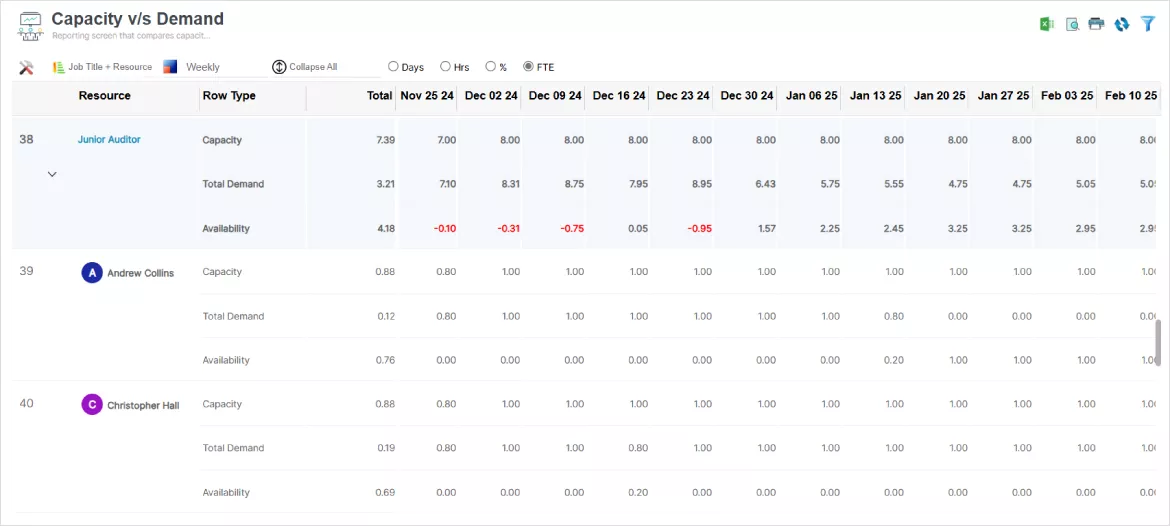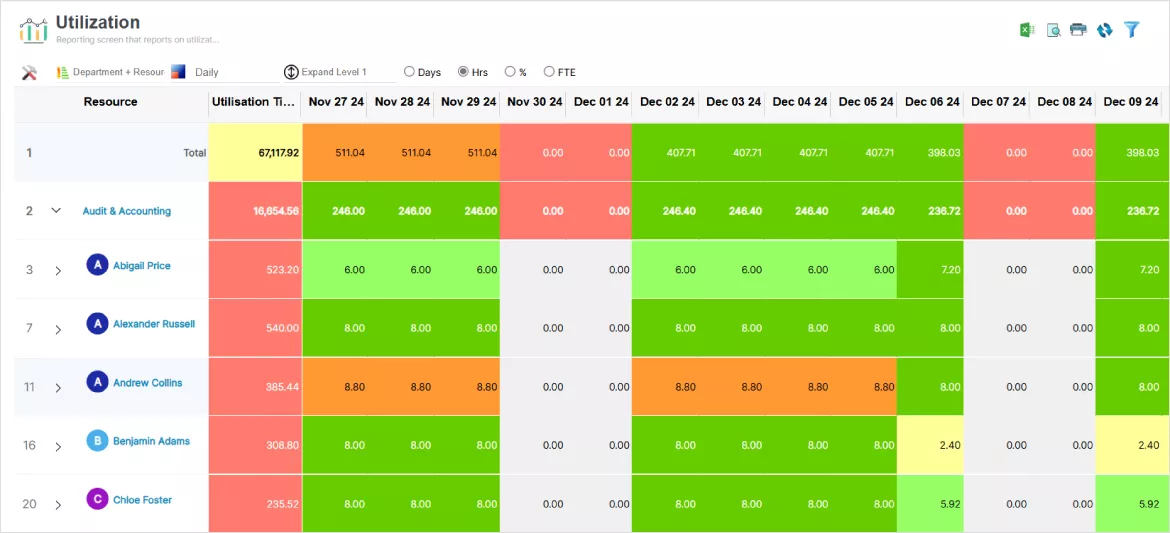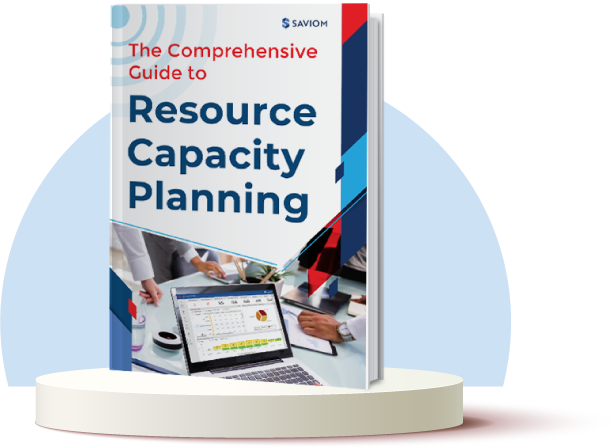Every organization thrives on having “The RIGHT people, with the RIGHT skillset, in the RIGHT roles, at the RIGHT time and cost.”
But is it possible to achieve this year-on-year?
This is where efficient workforce planning comes into the picture. It enables the HR departments to strategize for their future goals to make this achievable.
The workforce is undoubtedly the most vital and expensive asset for every organization. So, if not carefully planned, measured, or optimized, it can adversely affect any business’s top and bottom lines.
This article explores the concept of workforce planning, its different types, benefits, and covers strategies to boost business efficiency.
But first, let’s start with workforce planning definition.
What is Workforce Planning?
Workforce planning is the process of forecasting, analyzing, and ensuring that the right number of human resources are available for the right role at the right location at the right cost with the right competencies at the right time.
In other words, it is a process of matching the workforce’s capacity and capability to meet its current and future demands. By forecasting future work demand, organizations can identify the gap against the capacity so that the necessary resourcing steps can be taken to bridge the gap.
Principles of Workforce Planning
Workforce planning ensures an organization has the right skill sets and proficiencies to achieve its short and long-term business goals. Here are the four principles:
- Adaptability to market volatility – Workforce planning enables firms to anticipate and respond to dynamic business conditions. This involves analyzing industry trends, anticipating shifts, and maintaining a flexible talent pool to meet evolving business needs.
- Combat operational efficiencies – Effective workforce planning identifies skill gaps, workload imbalances, and bottlenecks, enabling optimized resource allocation. By ensuring the right people are in the right roles, organizations can streamline processes and improve productivity.
- Minimize labor costs – Workforce planning allows firms to control labor costs by creating and maintaining a blended pool of cost-effective local & global, permanent & on-demand workforce based on project requirements. Moreover, it emphasizes skill development, minimizing the need for costly external hiring.
- Future-proof the workforce – Workforce planning facilitates demand forecasting for pipeline projects, enabling managers to implement appropriate L&D initiatives to meet these staffing needs. Further, it helps identify high-performing candidates with impeccable work records for succession planning, thus future-proofing the workforce.
Given its definition and principles, let us explore the various workforce planning types.
Types of Workforce Planning
There are primarily three types of workforce planning: strategic, operational, and tactical. Let’s examine each one in detail.
Strategic Workforce Planning
A strategic workforce plan focuses on aligning the organization’s human resources with its long-term vision, typically spanning three years or more. It proactively anticipates future workforce needs to ensure the organization has the skills to achieve its objectives. Key benefits include:
- Support the organization’s long-term goals
- Address external workforce factors that affect the entire business
- Maintain organizational capacity
- Mitigate risk associated with workforce gaps
Operational Workforce Planning
Operational workforce planning helps decide what needs to be done to achieve the business’s immediate priorities, typically within a six-to-twelve-month timeframe. This approach focuses on creating realistic plans to achieve unit-level objectives while complementing the broader strategic plan. Here’s how it assists:
- Drives day-to-day operations efficiently
- Creates a judicious mix of permanent & contingent and junior/senior workforce
- Helps address current skill demands
- Foresees and manages seasonal workforce needs
Tactical Workforce Planning
Tactical workforce planning bridges the gap between strategic and operational planning, addressing short- to medium-term workforce needs. This approach emphasizes adaptability to project demands and market conditions while aligning with broader organizational goals. Key benefits include:
- Assess current and future workforce demands
- Better cost management
- Maintains operational efficiency
- Adapts to business changes
Let us understand the concept better with a workforce planning example.
Workforce Planning Example
Scenario: A technology company preparing for a major product launch
Strategic Workforce Planning:
The company plans to launch a groundbreaking AI-driven product in three years to gain a competitive edge in the market. For this long-term goal, the organization creates a strategic workforce plan focusing on:
- Future Skill Requirements: Identifying the need for AI specialists, data scientists, and user experience (UX) designers.
- Talent Acquisition Strategy: Partnering with universities, establishing internships, and building a strong employer brand to attract top talent.
- Upskilling Existing Employees: Offering training programs in AI and cloud computing for current employees to ensure internal expertise.
- Risk Mitigation: Developing succession plans for critical roles and ensuring knowledge transfer to avoid disruptions.
Operational Workforce Planning:
With the product launch scheduled for the following year, the company focuses on immediate staffing needs to meet development milestones. The operational workforce plan includes:
- Hiring Needs: Recruiting software engineers and quality assurance specialists to meet current project demands.
- Skill Alignment: Conducting skill gap analyses to ensure employees are equipped to meet project deadlines.
- Workforce Structure: Maintaining an optimal mix of full-time employees and contingent workers to balance workload flexibility and costs.
- Team Coordination: Creating cross-functional teams involving R&D, marketing, and customer support for a cohesive launch strategy.
Tactical Workforce Planning:
During the final six months before the launch, the company emphasizes short-term adjustments to handle last-minute challenges. Tactical workforce planning involves:
- Resource Realignment: Reallocating team members to critical tasks as priorities shift closer to the launch date.
- Flexible Staffing: Bringing in temporary contractors for testing and deployment phases to handle workload spikes.
- Monitoring & Adaptation: Using workforce analytics tools to track project progress and quickly address delays or resource shortages.
- Tactical Workforce Planning: Adjusting budgets to avoid overspending while maintaining efficiency.
Outcome:
Through strategic, operational, and tactical workforce planning, the company successfully launches its product on schedule. Strategic efforts ensured a skilled workforce was in place, operational planning addressed project-specific needs, and tactical adjustments enabled agility in the critical pre-launch phase.
This detailed example showcases how all three workforce planning categories interconnect to achieve a major organizational objective.
Read More: What is Resource Management? A Comprehensive Guide
Now, let’s look at some of the significant benefits workforce planning can offer your organization.
What are the Benefits of Workforce Planning for Organizations?
Workforce planning is a strategy that offers organizations numerous benefits, from enhancing operational efficiency to driving long-term growth.
Let’s explore these advantages in detail –
Helps Foresee and Bridge the Demand and Supply Gap
Workforce planning enables organizations to predict future demands and identify gaps using capacity vs. demand analysis. This helps firms take the proper resourcing measures to mitigate shortages or excesses of resources. For example, managers can proactively implement training or planned hiring for the shortage or actively market excess capacity to bridge this gap, eliminating last-minute firefighting.

SAVIOM’s detailed Capacity vs. Demand report enables managers to quickly detect and address workforce shortages or excess before they become issues.
Reduces Expensive Hiring/Firing Cycles
SHRM says, “The average cost per hire spiked to $4700 in 2023 from $4129 in 2019, which is approximately a 14% increase.”
Workforce planning mitigates this financial burden by focusing on long-term talent strategies, such as upskilling existing employees and redeploying internal resources, rather than relying heavily on external recruitment. By forecasting demand and analyzing current resource availability, organizations can identify skill gaps well in advance and address them accordingly, thereby reducing hiring costs.
Read More: How Resource Management Helps in Reducing the Hiring/Firing Cycle?
Minimizes Unplanned Attrition
According to the Work Institute 2024 Retention Report, “in 2023, almost 45 million workers left their employer voluntarily, a 37% increase since 2014.”
Workforce planning helps minimize unplanned attrition by addressing the underlying factors that drive employees to leave. Through proactive resource management, firms can ensure employees are appropriately utilized, engaged, and given growth opportunities. Further, they can identify potential retention risks early and implement career advancement opportunities like IDPs to ensure workforce stability.
Makes Your Workforce Future-Ready with Training/Upskilling
Technological advancements and shifting market demand often require employees to acquire new competencies. By anticipating these needs, workforce planning enables firms to prepare their workforce for emerging challenges and opportunities. Firms can opt for measures like training/upskilling, job rotation, cross-departmental collaboration, peer-to-peer coaching, etc., and foster a culture of continuous learning, keeping them agile in the market.
Read More: How Can Retraining/Upskilling Future-Proof Your Workforce?
Helps in Succession Planning for Critical Positions
Workforce planning plays a vital role in succession planning by identifying and preparing employees for critical positions within an organization. By analyzing workforce data and mapping out future leadership needs, firms can proactively identify high-potential employees who can step into key roles when needed. This approach ensures business continuity and minimizes disruptions caused by unexpected vacancies in essential positions.
Let’s dive into the essential steps to craft a strategic and effective workforce plan.
Key Steps to Create an Effective Workforce Plan
An active workforce planning process is not a singular action but a step-by-step process that aligns with the business goals.
Here are the five distinct steps in workforce planning –
Understand the Organization’s Overall Goals
In this first step, the HR personnel must partner with seniors to understand strategic objectives and drivers of business success. Some of the vital questions to ask before analyzing the workforce are –
- What are the future goals/initiatives of the organization?
- What talent does the organization need to reach the next level?
- How prepared is the organization for growth?
These questions help determine strategic areas and identify roles that deliver results in line with business goals.
Assess Current & Future Workforce Needs
Here, HR must collaborate with project managers to understand the resource requirements of ongoing and pipeline project opportunities, including quantity, quality, cost, skills, expertise, etc. Here are a few questions to ask for better analysis –
- What are the current strengths and weaknesses of the existing workforce?
- How do market trends or technological advancements impact workforce needs?
- What roles are critical to the organization’s short- and long-term success?
This analysis forms the foundation for developing actionable strategies to align workforce capacity and capabilities with business goals effectively.
Conduct a Supply & Demand Gap Analysis
The next step is forecasting the organization’s work requirements and analyzing the available skill set. It encompasses knowing the number of employees, their skills, and their demographics. Organizations need to understand –
- What is the most critical talent gap?
- Which skills would help organizations achieve their goals sooner?
- Is it better to hire a mid-level or senior-level talent?
This will give you a clear picture of your workforce capabilities, based on which managers can implement necessary measures if there is any shortage or excess.
Read More: What is Capacity Planning? An Ultimate Guide for Business Efficiency
Formulate a Plan to Mitigate the Gap
Next, HR needs a plan to address those gaps. A few talent strategy initiatives include – new recruitment, rewarding top talent, training/upskilling, or hiring contingent resources. To ensure the above plan is managed correctly, HR should know –
- Is the requirement one-time or recurring?
- Is it cost-effective to hire a new employee or to continue with training/upskilling programs?
- Does the organization have a succession plan to fill critical positions?
Organizations must formulate a mitigation plan that aligns with their hiring strategy to meet the demands.
Monitor and Control the Workforce Plan
Once the plan is implemented, HR and the leadership should establish metrics and benchmarks to evaluate the plan’s effectiveness. This helps track progress, assess outcomes, and make adjustments as needed. Some questions to ask are:
- Are the workforce initiatives delivering the desired results, or are there gaps?
- How effectively is the organization adapting to changes in workforce needs?
- What feedback from employees and stakeholders can improve the plan?
By continually refining the plan based on data and feedback, organizations can sustain their workforce’s efficiency and alignment with long-term strategic goals.
Now that we have understood the steps, let’s get on to the challenges of workforce planning.
Major Workforce Planning Challenges
Enlisted are a few common challenges arising from inefficient workforce planning, derailing a project’s success.
Misalignment Between Workforce Strategy and Business Goals
When workforce planning is not aligned with overarching business objectives, it leads to inefficiencies and missed opportunities. This disconnect can cause talent shortages in critical areas, delayed project timelines, reduced ROI, and an inability to respond effectively to market demands.
Difficulty in Forecasting & Bridging Skill Gaps in Advance
Limited visibility into upcoming projects and ineffective resource forecasting can leave organizations struggling to identify skill gaps proactively. This often results in mismatches between resource capacity, demand, and skill obsolescence. As a result, it restricts the organization’s ability to seize future opportunities.
Inability to Address Immediate & Seasonal Project Demands
A lack of proactive forecasting and planning often forces managers to recruit suboptimal or expensive resources at the last minute to meet urgent needs. This drives up resourcing costs unnecessarily. Thus, when demand subsides, companies are often compelled to downsize, resulting in a cycle of frequent hiring and layoffs.
Sudden Increase in the Bench Size
During project ramp-downs, a spike in bench size often stems from poor workforce planning, including inadequate demand forecasting, resource scheduling, or misaligned hiring. If not addressed, this can lead to disengaged employees, higher attrition, and reduced profitability and efficiency.
Sub-optimal Resource Utilization Rates
When organizations fail to align the right resources with the appropriate tasks, it results in underutilized employees. This can be due to inadequate forecasting, poor workload management, or a mismatch between employees’ skills and job requirements, reducing productivity.
Ineffective Employee Retention and Succession Planning Strategy
Intense market competition makes it difficult for organizations to attract and retain talent. Many companies fail to offer adequate career growth and fair compensation, leading to higher attrition. Further, when critical resources retire or leave without suitable replacements, it disrupts workflow and productivity, making the company vulnerable to disruptions.
Read More: 12 Simple and Effective Ways to Reduce Employee Turnover in 2024
Having understood the challenges, let us focus on workforce planning strategies for organizations.
6 Workforce Planning Strategies to Boost Business Efficiency
Given below are some efficient workforce planning strategies that help firms improve business growth –
Align Talent Acquisition Strategy with Business Goals
This strategy ensures that the organization attracts and hires candidates whose skills and experience directly contribute to achieving strategic objectives. This approach requires close collaboration between HR and business leaders to understand current and future workforce needs, market trends, and organizational priorities.
By aligning talent acquisition strategies with these goals, firms can secure high-caliber talent and reduce time-to-hire. This ensures that workforce capabilities are well-matched to both immediate and long-term demands, ultimately increasing productivity rates and driving organizational success.
Foresee & Bridge Demand Gaps Proactively
Organizations must always be prepared to meet evolving business demands. Therefore, it is essential to know whether they have enough capacity to meet these needs. For that, firms must perform efficient demand forecasting and capacity vs. demand analysis to anticipate future workforce requirements and to identify potential shortages or excesses.
This forward-looking approach allows organizations to implement targeted strategies such as upskilling, reskilling, or strategic hiring for shortages and selling excess capacity at discounted rates for excess. Thus, this assures alignment between workforce capacity and demand while maintaining operational excellence and competitiveness.
Read More: What is Capacity Requirement Planning, and Why is it Important?
Create a Balanced Mix of Resources
Another vital workforce planning strategy involves blending permanent/contingent, senior/junior and local/global staff to meet organizational needs efficiently. This approach allows firms to maintain a stable core workforce while leveraging flexible resources to address seasonal peaks, project-specific demands, or market fluctuations.
Also, by creating such a workforce, firms can ensure that niche-skilled workers are assigned to high-priority work, increasing utilization. Furthermore, this allows firms to hire resources of the same expertise from low-cost areas, thereby improving cost efficiency. Thus, firms can ensure resource availability and maximize operational agility.
Manage Ramp-up & Ramp-Down Effectively
Effectively controlling ramp-up and ramp-down processes is a crucial workforce planning strategy that ensures an organization can adapt to changing project needs without disruption. This involves accurately forecasting project timelines and resource requirements to manage the workforce up or down as needed.
Proper management during these phases helps reduce the risk of talent shortages or excess bench time and maintains operational efficiency. Thus, firms can optimize costs, enhance employee productivity, and sustain workforce engagement throughout different stages of project life cycles.
Read More: How to Balance Ramp-Ups and Ramp-Downs in a Project?
Maximize Billable and Strategic Workforce Utilization
Enhancing billable and strategic employee utilization is an essential workforce planning strategy that maximizes revenue generation. This involves mobilizing resources from non-billable, mundane, or low-value tasks to billable projects, ensuring that employees are deployed where they can contribute most effectively to the organization’s profitability.
Furthermore, setting clear utilization targets for permanent and contingent workers helps track productivity, manage resource allocation effectively, and optimize operational costs. By aligning workforce deployment with strategic business priorities, firms can improve profitability while maintaining a motivated and engaged workforce.

SAVIOM’s comprehensive Resource Utilization reports and visually intuitive color-coded heatmaps help managers effortlessly enhance workforce efficiency.
Offer Tailored Training and Development Programs
Customized training and development programs are essential for aligning the workforce’s skills with the evolving needs of the business. This involves identifying specific skill gaps and offering targeted learning opportunities to ensure employees are equipped with the competencies required for current and future roles.
These programs foster employee growth, enhance job satisfaction, and improve productivity. Additionally, focusing on personalized development helps retain top talent, reduce skill obsolescence, and ensure that the workforce remains adaptable to changing market conditions and organizational goals.
The following section will discuss common workforce planning techniques HR uses in an organization.
Workforce Planning Techniques
Firms must utilize proven workforce planning techniques to ensure the above workforce strategies effectively meet business goals. Here are some methods that HRs can use-
9-Box Grid
The 9-Box grid is a widely used grid-based talent management and succession planning tool that helps HRs align talent strategy initiatives with long- and short-term organizational objectives. In this tool, the employees are divided into nine groups of 2 dimensions, namely potential and performance.
The grid helps organizations identify high performers with strong potential for leadership, recognize employees who need development, and pinpoint those who may not be suitable for future growth. Through this visualization, managers can make informed decisions regarding succession planning, targeted training programs, and career development strategies.
Compensation and Benefits Analysis
This technique evaluates and optimizes an organization’s compensation structures and employee benefits to effectively attract, motivate, and retain talent. This analysis compares the organization’s compensation packages against industry standards, market benchmarks, and competitors.
By assessing salary levels, bonuses, benefits, and other incentives, organizations can identify gaps and make informed adjustments. This technique not only helps maintain employee satisfaction and reduce turnover but also ensures that overperforming employees are compensated adequately and your underperforming employees are paid accordingly.
Scenario Planning
Scenario Planning helps firms prepare for the future by exploring different possibilities and their implications on workforce needs. This method involves creating and analyzing multiple future scenarios based on variables such as workforce availability, capacity, economic trends, technological advancements, market shifts, etc.
This technique allows businesses to anticipate potential challenges, identify skill gaps, and allocate resources more effectively, ensuring they are prepared for uncertainties. Thus, scenario planning helps organizations remain agile, minimize risks, and optimize workforce deployment in response to future trends and disruptions.
Strategic Workforce Planning Map
A Strategic Workforce Planning Map is a structured framework organizations use to align their workforce strategy with long-term business objectives. This tool visually represents the process of identifying current and future talent needs, ensuring that the right skills and resources are in place to achieve strategic goals.
The map outlines key elements such as workforce forecasting, skills inventory, talent acquisition, development plans, and succession planning, integrating data on market trends, labor availability, and emerging industry requirements. Ultimately, it supports informed decision-making, fosters long-term business growth and sustainability.
Read More: What Is Strategic Workforce Planning and Why It Is Important?
Next, we shall explore how an advanced workforce planning tool helps in boosting business efficiency.
How can a Modern Workforce Planning Tool Help?
Workforce planning can enable organizations to maximize the potential of their human capital. Let’s look at how organizations can leverage robust workforce planning software to implement an effective workforce plan:
- Enterprise-wide visibility- The tool offers 360-degree resource visibility into critical metrics such as demand, availability, capacity, financials, etc. This enables organizations to evaluate workforce capacity and project demand for current and future opportunities.
- Forecasting and capacity planning- The tool’s forecasting and capacity planning capabilities allow managers to identify and mitigate capacity vs. demand gaps ahead of time.
- Real-time reporting analytics- The tool’s intuitive dashboards and reports, like utilization heat maps, and people on the bench, provide real-time, in-depth insights into KPIs, helping managers to identify potential bottlenecks early.
- Competency matrix- The in-built competency matrix captures and maintains the professional attributes of the workforce. It helps organizations to keep track of their resources’ capabilities.
- What-if analysis- The what-if analysis facility of the tool enables managers to simulate various scenarios and compare them to pick the most well-suited workforce plan.
Read More: How Scott Automation Redefined Resource Forecasting with SAVIOM
Conclusion
Effective workforce planning is key to achieving both short-term and long-term success. By aligning strategies with business goals, forecasting skill needs, and optimizing resource use, companies can overcome challenges like skill gaps and seasonal demands. This boosts efficiency, reduces costs, and supports sustainable growth, ensuring the organization is prepared for future opportunities and market changes.
The Glossary
Read More: Glossary of Resource Workforce Planning, Scheduling and Management












